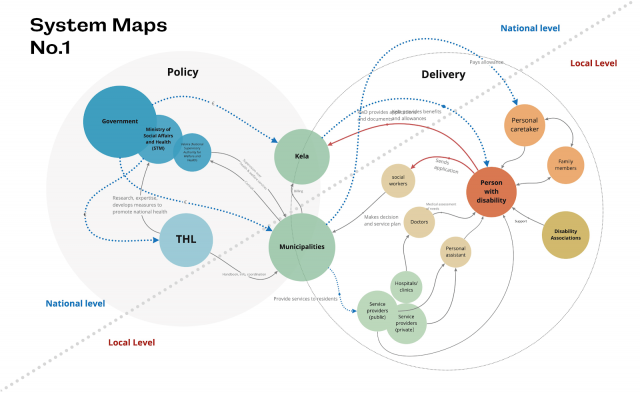This blog post reports on work-in-progress within the DfG course! The post are written by the group dealing with the brief on ‘Pilot project for Personal Budgeting Model’, provided by the Ministry of Social Affairs, Finnish Institute for Health and Welfare (THL), and the Social Insurance Institution of Finland (Kela) in collaboration with the ORSI project.
—
Group 1A: Senni Alho, Katriina Kenttamies and Naiquan Gu from the Creative Sustainability program, and Ondřej Zajíc from the Collaborative and Industrial Design program.
It is the fifth week of the Design for Government course, and our group, 1A, has dived deep into the system of disability services trying to understand the viewpoints of its different actors. We have been focusing especially on the end-users of the system to acquire more human-centred perspectives. After interviewing ten people and gathering data from a dozen documents, we have slowly acquired a fairly comprehensive understanding of the system and started to recognize some patterns in the data. From the patterns, we were able to generate eight key insights that we presented to a group of stakeholders in the Mid-Term Review on the 29th of March.
Two Emerging Themes
Our group identified two underlying themes that most of the key findings were related to: communication and imbalance of responsibilities and resources. We found that the siloed system does not encourage free information flow, and communication is insufficient between almost all the actors in the system (see Picture 1). The lack of communication results in difficulties for both the people and the organizations.
The second theme – the imbalance of responsibilities and resources – refers to situations, where a group of people does not have the necessary resources to carry out their duties. Our understanding is that the situation is particularly problematic among social workers and personal caretakers. This imbalance has a direct impact on both the lives of workers and people with disabilities.
Discovering Synthesis
We proposed that one of the two themes, communication or imbalances, could potentially be the focus of our design for the project. Based on the feedback, the stakeholders were more inclined to the communication design path. However, some very interesting points were made that communication might encompass both themes – at least partly. As Mira Koivusilta from THL pointed out, focusing on communication could have the potential to solve structural problems too:
“If we understand each other better then the siloes suddenly lower.”
– Mira Koivusilta, THL.
To conclude, our group has a lot of work ahead with identifying and analyzing different options of directions for the project. Even though it sometimes feels tempting to start defining the final design outcome, we have certainly learned to value the deliberate processes of this project. Having enough time for research and analysis often leads to more considered results.

—
